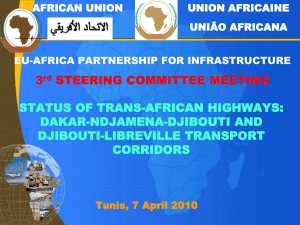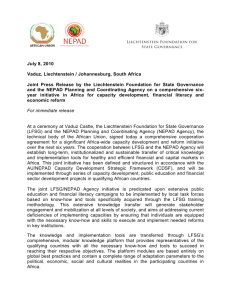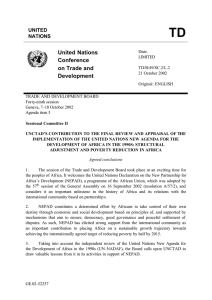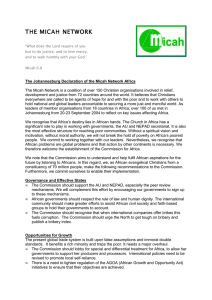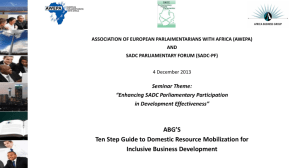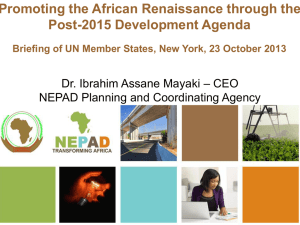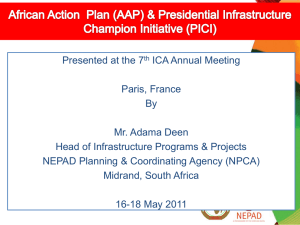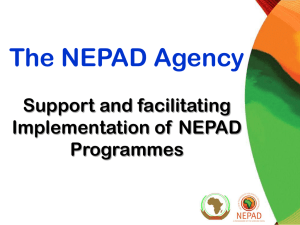Joint Facilitation Meeting on WSIS Action Line C2, C4, C6
advertisement
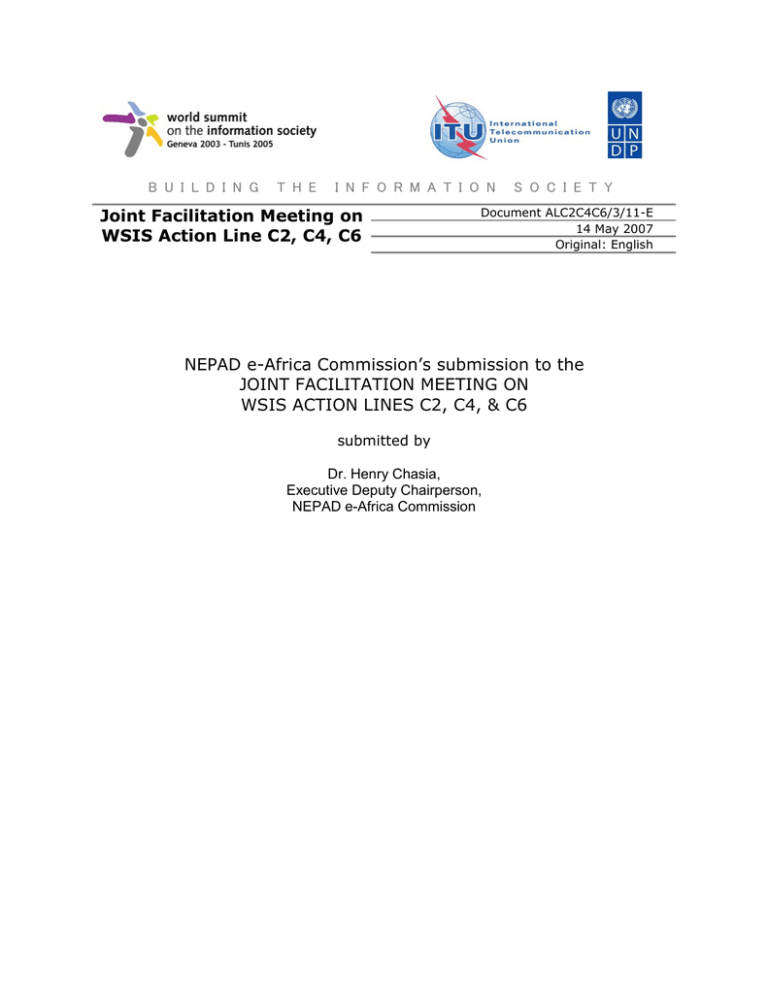
B U I L D I N G T H E I N F O R M A T I O N Joint Facilitation Meeting on WSIS Action Line C2, C4, C6 S O C I E T Y Document ALC2C4C6/3/11-E 14 May 2007 Original: English NEPAD e-Africa Commission’s submission to the JOINT FACILITATION MEETING ON WSIS ACTION LINES C2, C4, & C6 submitted by Dr. Henry Chasia, Executive Deputy Chairperson, NEPAD e-Africa Commission NEPAD e-Africa Commission’s submission to the JOINT FACILITATION MEETING ON WSIS ACTION LINES C2, C4, & C6 ITU Headquarters Geneva, Switzerland May 16, 2007.05.14 By Dr. Henry Chasia, Executive Deputy Chairperson, NEPAD e-Africa Commission NEPAD e-AFRICA COMMISSION CSIR Building 43B, Meiring Naude Road P O Box 395, Lynnwood Pretoria, RSA, 0001 Tel +27 12 841 4083 Fax +27 12 841 4094 Email hchasia@eafricacommission.org www.eafricacommission.org Copyright in this document is owned by the NEPAD e-Africa Commission and the whole or any part thereof, may not be reproduced and/or published, in any form, without its prior written consent. Any unauthorized reproduction and/or publication will be an infringement of international copyright laws. NEPAD e-AFRICA COMMISSION’S SUBMISSION TO THE JOINT FACILITATION MEETING ON ACTION LINES C2, C4, AND C6 1. Background The Consultative Meeting on Implementing WSIS outcomes related to Action Line C2, held in Geneva on 18 May, 2006, recognized the appropriateness of envisioning the creation of sub-groups based on priority themes relevant to ALC2 and concrete initiatives requested by countries. Of particular relevance to the NEPAD e-Africa Commission’s activities, are the themes relating to reinforcing regulatory capacities at the national level and the harmonization of legal and regulatory frameworks at the regional level. The meeting stressed the need to put more focus on the implementation of concrete and impact making initiatives submitted to this process by countries. The meeting further acknowledged that developing ICT Infrastructure is one of the eReadiness factors for the development of ICT-enabled applications. Also, in response to the call by African leaders, the World Telecommunications Conference (WTDC-02) adopted Resolution 35 in which it expressly calls for the Telecommunications Development Bureau (BDT) to pay particular attention to the needs of Africa as defined by the New Partnership for Africa’s Development (NEPAD). This was subsequently endorsed by the ITU Plenipotentiary Conference Resolution 124 (Marrakech, 2002). The NEPAD e-Africa Commission is the NEPAD ICT Task Team responsible for developing the NEPAD ICT program and implementing its projects. Its mandate is to manage the structured development of the ICT sector on the African continent, in the context of NEPAD. 2. ACTION LINE C2: Information and Communication Infrastructure The NEPAD e-Africa Commission has approached the execution of its mandate in the ICT Infrastructure area by working towards the development of two regional networks, and a continent-wide satellite network: 1. NEPAD ICT Broadband Infrastructure Network for Eastern and Southern Africa; comprising of a submarine (EASSy cable) segment, and a terrestrial segment. 2. NEPAD ICT Broadband Infrastructure Network for Central, West and North Africa. 3. The NEPAD e-Schools satellite network. 1 2.1 NEPAD ICT Broadband Infrastructure Network for Eastern and Southern Africa A basic rationalized broadband ICT network for Eastern and Southern Africa, as in 1 above, was agreed by stakeholders during a workshop convened by the NEPAD e-Africa Commission in Johannesburg, 28 to 30 July 2004. The agreed network brought together a number of network development initiatives in the region, such as COMTEL, SRII and the EASSy cable, into a cohesive plan for progressing the development of the agreed basic network. The network was subsequently adopted as a NEPAD flagship project by the twelfth summit of the Heads of State and Government Implementation Committee (HSGIC) of NEPAD, in Algiers, Algeria, on 23 November 2004. With a view to resolving policy and regulatory issues that may impede or prevent the realization of the rationalised network, the NEPAD e-Africa Commission worked with Government ICT Experts, ICT Policy Advisors, Regulators, Civil Society, Legal Experts, Executives of Telecom Companies, and Development Funding Institutes to develop a policy and regulatory framework within which the network. The work of these stakeholders in creating an enabling environment is discussed in section 3 below. The policy and regulatory framework which was developed by the stakeholders is enshrined in a ministerial protocol which 12 countries have signed and others may accede to. The regional network will be redesigned to accommodate initially only those countries that signed the Protocol. The network will be a contiguous one, stretching from South Africa to Uganda, and linked to Madagascar and Mauritius. In due course, as other countries accede to the Protocol, those countries will be incorporated into the NEPAD network. See Attachment 1. The protocol provides for the establishment of an Inter-Governmental Assembly (IGA), and in the first meeting of the Interim IGA, on 15th December, 2006, the Commission was authorized to seek funding, in relation to the submarine segment, for a re-scoping study whose outcome will be an optimum configuration that includes: 1. landing points in those countries that have signed the Protocol; 2. the location of branching units to cater for landing points in those countries that accede to the Protocol in the future, as may be decided; 3. a preferred anchor point in the Northern Hemisphere. The Interim IGA also authorized the Commission, in relation to the terrestrial segment, and in collaboration with SATA and COMTEL, to conduct a study that will ensure that, as a minimum, the requirements of 2 the 12 countries that have signed the Protocol, and those that accede in the future, are part of the terrestrial network. Noting the need to fast track the implementation of the submarine cable, the Interim-IGA also authorised the Commission to initiate discussions with interested and capable parties, with a veiw to establishing a Project Implementation Team. The tasks of the Project Implementation Team will be more fully developed by the Commission, but will include: a) the need to establish and operationalise the submarine Special Purpose Vehicles and their domicillium in Kigali, Rwanda. b) the development of technical, financial, and commercial plans related to the submarine segment of the network and it implementation. c) the scoping and reconfiguration of the submarine and terrestrial segments of the network and associated feasibility studies and plans. In January 2007, the Commission submitted a request for support, with budget estimates, to the ITU, covering: 1. Harmonization of the policy and regulatory environments in the 12 signatory countries, 2. A rescoring and feasibility study for the submarine segment, 3. A feasibility study for the terrestrial segment, and 4. Establishment of a submarine Project Implementation Team. 2.2 NEPAD ICT Broadband Infrastructure Network for Central, West and North Africa. In July 2005, the e-Africa Commission hosted a workshop in Dakar, Senegal, that was attended by ICT Policy Advisors, ICT Regulators, Telecommunications Operators, other utility infrastructure operators (i.e. power line, gas, and oil pipeline), and Development Funding Institutes (DFIs). The outcome of the workshop was an agreed basic broadband ICT network for Central, West and North Africa. This network has submarine and terrestrial components. See Map in Attachment 2. With support from the African Development Bank (AfDB), the e-Africa Commission has engaged a consultant to validate existing and planned ICT infrastructure projects in this region. This information is very important for proper planning and coordination of efforts. This exercise should be completed in July 2007. Once the planning of the network has been finalised and agreed by all stakeholders, a feasibility study for the terrestrial and submarine 3 components of the network will be undertaken. One output from this feasibility study will be an estimated capital cost of building the required infrastructure. Funding will be required in both cases. This regional network will be interconnected with the network in Eastern and Southern Africa, resulting in a contiguous network across the continent. See Map in Attachment 3. The NEPAD e-Africa Commission is looking for funding support to recruit a Project Manager who will spearhead activities in this region including liaising with stakeholders. 2.3 NEPAD e-Schools Satellite Network While the NEPAD ICT Broadband Programme aims at connecting all African countries to one another, and in turn to the rest of the world, through broadband connections, the two regional networks under development will serve only the major cities in each country. These will interconnect with the ICT backbone networks under development in the individual countries. However, these in-countries backbones will also only serve the main urban centres. In view of the size of the continent and the poor state of its ICT infrastructure, there is need to provide an overlay satellite network that will offer ICT broadband connectivity that will benefit the entire continent, especially the rural areas that will not be reached by optical fibre networks. The NEPAD e-Schools Satellite Network Project is primarily intended to offer Internet connectivity to over 600,000 NEPAD e-Schools via a satellite network based on leased space segment capacity. See Attachment 4: This satellite network has the potential to serve other projects which need broadband connectivity in areas not served by fibre optic networks. This network is thus designed to provide a platform for e-health, egovernance, elections activities, etc. In addition, when the Regional African Satellite Communications Organisation (RASCOM) becomes operational, it will be a potential source of capacity. Based on the first Expressions of Interest (RFI) issued in 2004 to the satellite industry for servicing the NEPAD e-Schools network and a second one in 2006 for satellite broadband service provision, the preliminary specification of this network provides sufficient definition to allow the acquisition management process to move forward. 4 The next steps will include the following activities which require financial support : The Acquisition of Management System The Specification of the Acquired system The Establishment of the NEPAD e-Schools Network Operations Centre (NOC) Follow-up operation and maintenance processes Budget on the above mentioned activities are broken down in the matrix below Budget NEPAD e-Schools Satellite Network Cost (US$) 400,000 Time frame 4 months 400,000 4 months Stage 3 Activities Acquisition of Management System and the Specification of the Acquired system (consulting job) Design network Design operating centre (consulting job) Establish Operations Centre, leasing capacity 300,000 550,000 Stage 4 Operations Centre: Shared infrastructure Monthly costs: Assuming 1000 sites using 10MBps forward 2Mbps return: $200k per month ($2.4mill p.a.) Establish national hubs... and VSATs (at e-school) Stage 1 Stage 2 6 months 2,400,000 p.a National hubs including grounds plus buildings 100,000 VSATs: external works, landed in country, installation ( $6000 each(*10 000 schools= $60 mill) (this figure can be reduced for volume discount and through negotiations) Setup operations, per VSAT operator: $150k Operations cost and ongoing operation Work on $50 per VSAT per month (to be paid to VSAT operators)(*10 000=$500k per month) NEPAD operations: 2 persons full time per VSAT network (assume 5 - 10 in total) + 5 - 10 others. All technical Stage 5 60,000,000 Depends, 3 months per hub which can be implemented in parallel Roll-out program over 2-4 years 150,000 500,000 p.m Ongoing 6 months to set up organisation and infrastructure support All technical. Add other staff e.g.. Secretary, HR, procurement, etc. (procurement agency needs to be The rollout of the NEPAD e-Schools Initiative is estimated to take ten years at an average rate of 60,000 schools per annum. The cost of satellite connectivity is estimated to US$450,million for the first years and thereafter US$ 400,million per annum 5 3. ACTION LINE C6: Enabling Environment 3.1 Enabling Policy and Regulatory Environment for the Eastern and Southern Africa Network With a view to resolving policy and regulatory issues that may impede or prevent the realization of the rationalised network, the NEPAD e-Africa Commission worked with Government ICT Experts, ICT Policy Advisors, Regulators, Civil Society, Legal Experts, Executives of Telecom Companies, and Development Funding Institutes to develop an enabling policy and regulatory framework within which the network, including the submarine (EASSy) cable, could be developed. The outcome of this was a Protocol which was signed by 12 countries. The Protocol will come into effect after it has been ratified by more than 50% (i.e. seven) of the signatory countries. This is expected to happen before July, 2007. After the Protocol has come into effect, any of the countries that were not able to sign the Protocol by the deadline of 30th November, 2006, may accede to the Protocol. At this stage, ICT Policy Advisors and Regulators in the signatory countries, and those that have acceded, will embark on a harmonisation process aimed at the re-alignment of national laws and regulations with the provisions of the Kigali Protocol. As part of a World Bank-funded consultancy to support the NEPAD eAfrica Commission, the Commonwealth Telecommunications Organisation (CTO) played a critical role in the development of the Protocol and in facilitating the consultation process that preceded the signing of the Protocol in Kigali. The CTO has submitted a Report to the Commission, which includes a draft licensing and interconnection framework that the signatory countries can use in the harmonisation process. In view of its intimate knowledge of the NEPAD broadband network and its role in the development of the Protocol, the CTO is well-placed to offer its expertise to those countries that may require assistance during their ratification and harmonization processes. It is in this context that the support of the ITU – BDT unit is being sought to fund any assistance that the CTO may be requested to provide to these countries. 3.2 Enabling Policy and Regulatory Environment for the Central, West and North Africa Network An enabling policy and regulatory framework will be developed along similar lines to, and drawing lessons from, the Eastern and Southern African process. Funding is required for this exercise, although the costing has not yet been done. 6 4. ACTION LINE C4, Capacity Building 4.1 NEPAD e-Schools Initiative In March 2003 in Abuja, the NEPAD Heads of States and Government Implementation Committee (HSGIC) endorsed the NEPAD e-Schools Initiative as one of the six high-priority NEPAD information and communication technologies (ICT) projects. The NEPAD e-Schools Initiative was publicly launched in Durban, South Africa at the Africa Summit of the World Economic Forum on June 12, 2003. The African Union has identified the NEPAD e-Schools as one of its priorities in its Action Plan: 2003 – 2007. The main components of this Initiative include: • NEPAD e-Schools demonstration project (Demo), • Business plan, • Content development and teacher training, • National Implementing Agencies, • NEPAD e-Schools satellite network. The NEPAD e-Schools initiative will involve around 600,000 primary and secondary schools in all African countries in three phases of fifteen to twenty countries each. Phase one involves the first twenty countries to have acceded to the African Peer Review Mechanism (APRM). These are Algeria, Angola, Benin, Burkina Faso, Cameroon, Congo, Egypt, Ethiopia, Gabon, Ghana, Kenya, Lesotho, Mali, Mauritius, Mozambique, Nigeria, Rwanda, Senegal, South Africa and Uganda. The overall purpose of the NEPAD e-Schools initiative is to impart ICT skills to young Africans in primary and secondary schools. The main features of the NEPAD e-Schools initiative include: • Participation by countries in the NEPAD e-Schools Initiative is voluntary. • Interested countries must commit to certain responsibilities in supporting the successful implementation of the Initiative. • The Initiative will make use of economies of scale by facilitating bulk multi-country purchasing of equipment and services. • A coordinated teacher training programme will facilitate the training of several thousands of teachers in many countries in a short space of time. • The Initiative will coordinate the ICT curriculum and content development across the continent. • e-Learning techniques will optimize the use of limited teaching resources in subjects such as mathematics and sciences. 7 • • • The stable long-term commitment by countries will create an attractive opportunity for private sector partners to provide products and services at affordable prices. Bulk purchasing of satellite capacity will bring significant reduction in cost of communication and access to the Internet. The Initiative will involve long-term planning by countries for maintenance and replacement policies, and will be coordinated continentally whilst being implemented nationally. There is an urgent need to ensure that the Commission and the countries are prepared and well equipped to manage the rollout of the Initiative. The success of the Initiative depends on the effectiveness of the implementation process to be coordinated by the Commission as well as the commitment by participating Governments to fund and implement it. Overall objectives of the NEPAD e-Schools Initiative: • • • • To provide ICT skills and knowledge to learners that will enable them to function in the emerging Information Society and Knowledge Economy, To provide teachers with skills to enable them to use ICT as tools to enhance teaching and learning, To provide school managers with ICT skills so as to facilitate the efficient management and administration in the schools, and To make every learner health literate. The Demo Project The purpose of the Demo Project is to accrue a body of knowledge based on real-life experiences of implementing ICTs in schools across the African continent, that will serve to inform the rollout of the NEPAD e-Schools Initiative The Demo Project is being implemented by five consortia in partnership with the participating country and NEPAD at the rate of six schools in each country. Five consortia, led by Microsoft, HP, Oracle, Cisco and AMD, are deploying equipment, educational content, connectivity and teacher training in participating schools. This process is expected to be completed by the end of 2007. To date the Demo has been launched in Uganda, Ghana, Kenya, Lesotho, Rwanda, Uganda, Egypt, South Africa and Mauritius. In most of these launches, the Head of Government or the President has officiated at the ceremony. 8 The Business Plan Contracted to Ernst & Young, the NEPAD e-schools Business Plan will be completed by June 2007. It will provide country strategies that outline the process, input and costs to which could be used to guide and inform the roll out of the NEPAD e-schools in the participating countries. In order to support national governments and regional Economic Communities in the implementation of the NEPAD e-schools, the NEPAD e-Schools Team at the e-Africa Commission must be strengthened to deliver on: i. planning and negotiation; ii. technical and conceptual support; iii. professional development support; and iv. Research, monitoring and evaluation. The above activities will amount to US$2.5million in the short terms (six months from the time of the Business plan ownership by governments) and to US$22 million for the three subsequent years. Monitoring and Evaluation Three Interim Monitoring and Evaluation reports on the Demo Project have been produced by the Commonwealth of Learning in partnership with the InfoDev of the World Bank(January & July 2006, March 2007). The Commission plans to continue this important aspect of the Demo Project until 31 December 2007. Content development and teacher training, The purpose is to facilitate a continental strategy outlining a framework for the development of high quality online curriculum content for African schools. In 2006, an expert was deployed by the ITU for 3 months to assist the NEPAD e-Africa Commission in developing a framework for the training of trainers in ICTs in line with the objectives of the e-Schools initiative. A follow up request to support the implementation of the thus developed framework has been submitted to the ITU. The above activities will amount to US$2million. National Implementing Agencies The Commission is mounting an effort in cooperation with the countries concerned, to develop national implementing agencies and afford them the capacity to manage the planning and execution of this project at the national level. This process will take three years at the cost of US$1m per country over this period (for a total of US$20million) Total support needed for the NEPAD e-Schools Initiative for the next three years: US$45 million. 9 Attachment 1: The NEPAD ICT Broadband Infrastructure Network for Eastern and Southern Africa EASS Capital city Cable station Repeater SAT 3 / SAF 10 Attachment 2: The proposed NEPAD ICT Broadband Infrastructure Network for West, Central, and North Africa. LINKS: Existing o Southern & Eastern Links Planned / Funded Required Proposed Submarine cables 11 Attachment 3: The NEPAD ICT Broadband Infrastructure Network for Africa. o 12 Attachment 4: NEPAD e-Schools Satellite Network 13
